|
|
|
|
SOYA DAIRY FOODS |
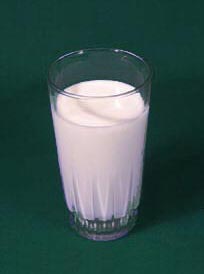 |
Soya BeveragesThere are two main types of soymilk drinks and general applications. The first is as a "plain" dairy alternative to cow milk, while the second is a range of flavored drinks. Each have somewhat different challenges in their processing. Dairy alternative soymilk must be very "bland" tasting to avoid the beany flavor, which is objectionable to many non-Asian consumers. It must also have similar functionality to cow milk, in drinks and food preparation. Even mildly flavored drinks such as vanilla, require a very bland soymilk base. This challenge requires sophisticated processing and formulation to achieve the neutral taste while maintaining a good mouth-feel. A high proportion of dissolved soymilk solids is desirable. Otherwise, the product may be like a suspension, with particles settling and causing mouthfeel problems such as chalkiness. Vacuum deodorization is a must, as part of the processing line. |
|
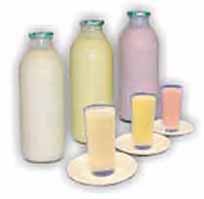 |
In addition, numerous other technical considerations are involved in achieving the best yield, taste, mouthfeel and functionality. Fortification with additional minerals and vitamins is an important option. It is generally not cost-effective to try to produce totally plain soymilk drinks in smaller quantities. Flavored soymilk drinks, particularly strong ones such as chocolate or some fruit flavors, are less of a challenge with the issue of the beany off flavor since they usually mask some of this. However, the base soymilk must still be relatively bland and highly functional. Vacuum deodorization may be optional depending on the final product and the quality of the main soymilk base production. This allows medium and smaller volume production with somewhat simpler processing equipment, however the flavoring formulas and mixing may be more complex. |
|
|
|
||
|
Top |
||
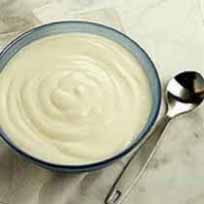 |
YogurtYogurt and its derivative foods and drinks are some of the easiest products to understand and produce for people with dairy food experience. The processing of soy yogurt is almost identical to that of cow milk, but with some very important differences. Formulation is required, primarily to add a simple carbohydrate such as sugar, to compensate for the missing lactose found in cow milk. The bacterial culture, which can be the same types as for cow milk, as well as others, needs the additional carbohydrate to feed and develop. Another ingredient may be required to reduce the surface separation of water, which occurs somewhat more than with cow milk. |
|
|
Inclubation time and temperature are also adjusted
compared to traditional yogurt. Soy yogurt can require 6-10 hours
or more of incubation at temperatures near 40 C. It is important to note that the soymilk base for making soy yogurt
products, does not have to be absolutely bland tasting and that
vacuum deodorization may not be necessary. This allows a less complex
system and also one with a medium or lower production volume. Nevertheless,
a good quality soymilk base is a must. |
||
|
Top |
||
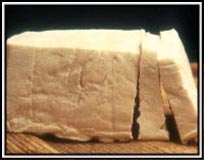 |
TofuThe most well-known and common soya dairy food is tofu. In Asia it has been consumed for maybe 2,000 years, with its beginnings in China. During the last twenty years, it has become well-known and respected in much of the world, and mainly the developed western countries. Now it is also beginning to be known in many developing countries. It is similar to existing cow milk cheese products such as paneer in India and peynir in Turkey, and is processed almost the same way. It therefore provides an excellent soy protein alternative to many traditional foods. |
|
| Pressing of the soymilk curds is done after the liquid whey water is drained away. The pressing can be manual, mechanical or hydraulic. After the pressing, the large blocks are cut and then cooled in a cold water bath. Formulation is also possible with tofu. The addition
of herbs and spices and other ingredients can make the product more
ready to eat and easier to prepare at home. Derivative foods such as patties, burgers, "cottage cheese" or quark, mayonnaise and other tofu-based foods are all highly viable but require careful formulation and processing. Packaging for the basic tofu is generally in either a plastic container including a water bath and plastic film-sealed top, or in a vacuum-sealed plastic wrap. Some stores simply sell it in bulk from a vessel with a cold water bath. Soymilk processing for tofu, as with yogurt, can be fairly basic
and at almost any volume of production. Some of the beany off-flavor
is gone with the drained whey water, and usually tofu is mixed with
other spices and cooked cover any residual beany flavor. Therefore
no vacuum deodorization is required in the soymilk line. |
||
|
Top |
||
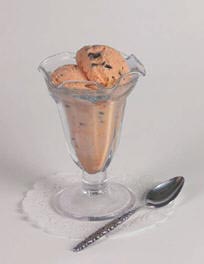 |
Ice CreamLike the yogurt category, soy-based ice cream is easy to produce for experienced dairy processors. When properly formulated and processed both hard and soft ice creams made from soymilk can equal the taste of most high-quality ice creams. Ingredients will vary depending on the product, but basically the same types are used as for traditional ice cream. One major difference is the need for additional oil and emulsifiers to offset the lack of saturated fat in soymilk. The mouth-feel associated with most commercial ice cream is partly related to the fat content, and so soymilk ice cream will benefit from the inclusion of a vegetable oil. Different stabilizers may be chosen as well. Equipment necessary for both hard and soft ice cream is identical to the cow milk versions. The difference is primarily in the ingredients and processing. |
|
|
|
||
|
Top |
||
 |
PuddingsA wide variety of puddings and desserts is possible with soymilk as the base. Basically any similar product made from cow milk, can be made with soymilk. The question of beany flavor and its treatment is similar to the case of ice cream. The more bland the base milk, the more subtle the possible flavors. Pudding can also be made with tofu, particularly silken tofu, but it is not clear that this is more cost effective than making it directly from soymilk. A thicker concentration of soymilk would be required than for beverages. Vegetable oil and emulsifier addition to enhance mouth-feel, and other ingredients to alter consistency, are considerations in this process. Packaging can be inexpensive, and like traditional refrigerated yogurt products. However, long life, non-refrigerated packaging is also available for this category. |
|
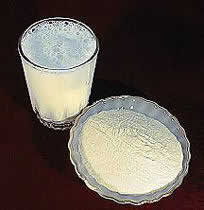 |
Soymilk PowderThe quality of the soymilk base is critical to the quality of the resultant spray-dried soymilk powder. Only very large volumes of production are feasible for spray-drying. However, other important technical considerations are also involved. Evaporation / concentration of the soymilk prior to spray drying must be less than the usual cow milk since soymilk viscosity would otherwise be too much for the process. Although the main part of the spray drying equipment for traditional
milk powder is used, some equipment modification is necessary to
be able to spray dry the soymilk. |
|
|
|
||
|
Top |
||
|
||
